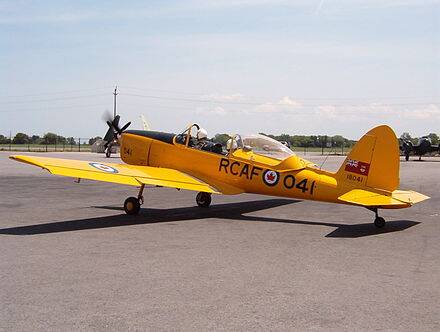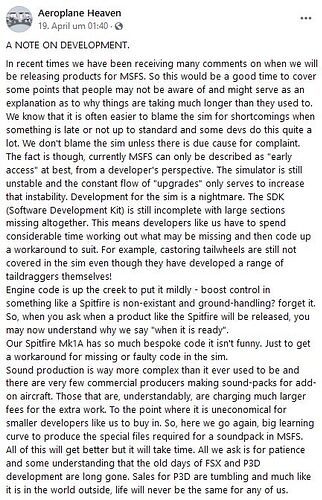One of the main problems in the flight model of msfs 2020 is his very poor physic in the landing. An example of this are the taildragger in which if a rough landing is made with the front wheels it does not bounce and sends you back to the sky, instead of that the plane behave as if had a tricycle landing gear. This makes landing little challenging and unrealistic, which makes it boring, since I think that the fun in a simulator is in acquiring the necessary skills to master any type of plane and if is more difficult is more fun. Even airplanes with tricycle landing gear are too easy to land. Asobo must to correct this behavior beacause the most fun and challenging part of a flight is the landing.
Are you sure you don’t have your landing assist accidentally turned on?
Yes im sure. I fly for a few years a luscombe 8 and if you dont make a perfect three point landing the plane bounce.
what is a three point landing?
You must make a touchdown with the three wheels at the same time. If you do that the plane dont bounce. That is why is more difficult land a taildragger
Ahh so landing with a completely level attitude?
But what’s a taildragger?
Sorry for the many questions. I’m only good with flying and landing airliners… I’m not really familiar with flying GA planes.
Are you on the ‘Modern’ flight model?
Taildragger are rhe plane with two wheels at front and one in the tail
Yes i use that flight model
Weird cos i have personally experienced the taildraggers bouncing on heavy landings, haven’t got the hang of landing them yet.
Heck I got bounces on the TBM 930… I can’t apply the same technique I use to land the A320 on a TBM.
You are ‘kind of’ correct. The Lusc is a handful and requires a firm hand. It is also one of those that prefers to be three pointed. That said, it is governed by the same rules as all taildraggers and will require pilots to be proficient at both techniques.
@Neo4316 @DORRAGER
Taildraggers are usually designed so that the angle of attack is beyond the stall when all three wheels are on the ground. This will prevent “ballooning” which is different from bouncing. Ballooning is when the wing is still producing lift and so makes it difficult to keep the aircraft in contact with the ground. The effect is aggravated when there is a gusty headwind. A puff of wind if enough to lift the aircraft into the air momentarily. When the gust subsides the plane drops back to the runway. If high enough and/or slow enough this can be catastrophic due to the nose high attitude resulting in a stall and the impact can be extreme. Ballooning will usually result in a bounce if not handled correctly and the pilot attempts to push the nose down to arrest the balloon.
Whether to “wheel land” or “three point” a landing depends on the aircraft. Some taildraggers do not like to be three pointed and some can be very difficult to land on the mains. Wind conditions will usually be primary factor when deciding which to use. It is FAR safer to wheel land ( aircraft in a near level configuration, touching down on the mains only ) if there is any significant crosswind as it allows the pilot to fly the aircraft to the ground and maintain alignment with the runway. If attempting a three point landing with a crosswind the pilot’s skill level can be severely tested. ANY crab angle maintained on touchdown will increase the tendency to ground loop. ( the tail wants to swing and momentum, if not instantly overcome, will rapidly become uncontrollable. )
Lots of factors involved here. Suffice to say that proficiency should always be the governor of technique. If you have a tendency to bounce your landings, go practice. Bouncing is caused by insufficiently arresting the descent rate at the moment of touch down. Ballooning is usually the result of attempting to three point with excessive speed.
If you want to safely fly a taildragger, spend WAY more time doing circuits than going places.
Nice post, I learned in the DeHaviland Chipmunk T10, quite a handful in crosswinds.
Have bounced many an Xcub on landing, so not sure what’s happening for you.
Big booty always wants your attention.

Look at the size of that tail
Flew a Super a few times taking aerobatics lessons. The Chipmunk will always hold a special place in my heart.
Very nice, love the canopy!
A long time ago I was asked by an ex-RAF pilot if I could make an improved FDE for a FS9/FSX Chippie and he sent my 11 manuals and lots of personal notes.
It’s always amazing when you are working with military or ex-military pilots, because there’s a significant difference compared to most civil pilots when it’s about remembering aircraft handling, especially if it’s more than a few month ago.
It required quite a few FDE versions, but in the end even spin entry was correct and you could spin the Chippie normal, flat and inverted.
I imagine that’s because civilian pilots have probably never done anything more aerobatic than an incipient spin or maybe a wingover. I will bet most will would lose their composure pretty quick if you put them in the back seat and threw some snap rolls or loose loops at them. Imagine their faces in an inverted flat spin! (Did one in an open cockpit Pitts Special. Was real happy to have the open cockpit. Much easier to hose off the fuse’ than spend all afternoon cleaning the cockpit)
It’s not only aerobatics, but basic pitch and power settings, speeds, pattern work etc.
